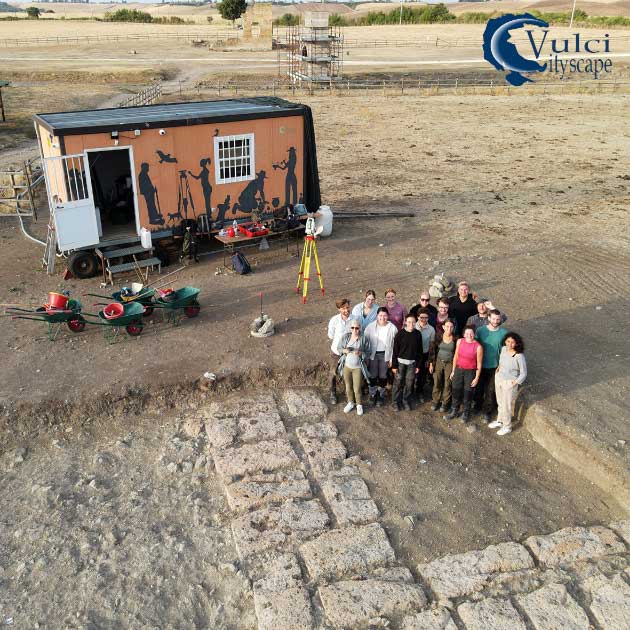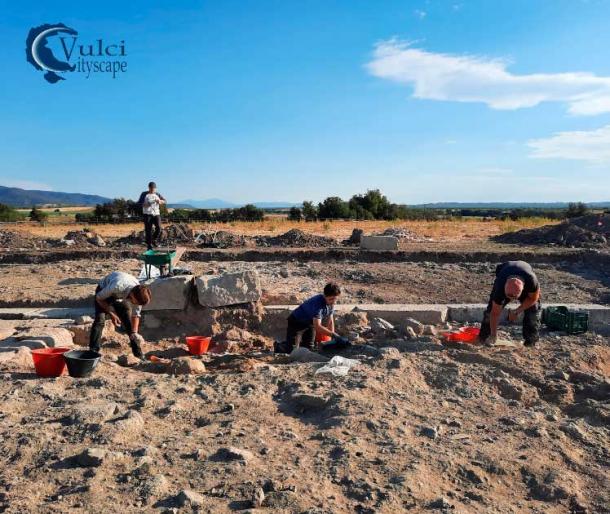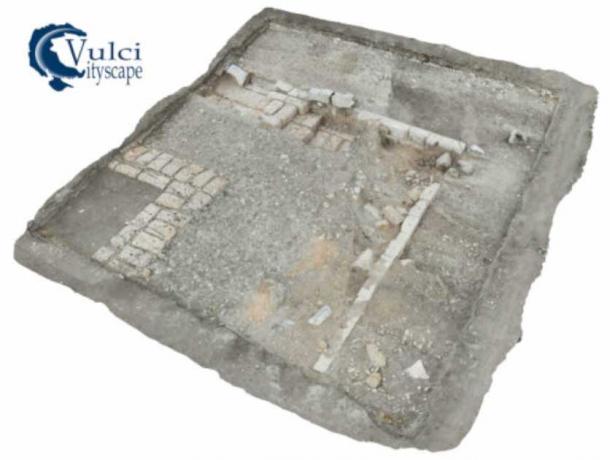A team of Italian archaeologists excavating at the ancient Etruscan city of Vulci has discovered a previously unknown of monumental temple near the legendary Tempio Grande sacred site.
The ancient temple was built near the Tempio Grande (grand temple) at the archaeological site of the city of Vulci . Located about 80 kilometers (49.7 miles) northwest of Rome on the coast of the Tyrrhenian Sea, between the municipalities Montalto di Castro and Canino, in the late 19th century archaeologists discovered thousands of ancient tombs, including the Tomb of the Sun and Moon, Then, in the 1950s, the Tempio Grande was revealed.
Since the 1950s excavations have revealed an archaeological area of around 900 hectares and every square inch is loaded with evidence of the city’s past. But nobody expected the discovery of this second temple, which in orientation, alignment and scale reflects the building dynamics measured in the Tempio Grande.

The excavation team in the field in summer 2022. (Mariachiara Franceschini / Vulci Cityscape )
An Ancient Center Of Culture And Arts
In the 6th century BC the city of Vulci was one of the twelve cities of the Etruscan federation. Developed by the people of Etruria, neighboring cultures that shared similar religious beliefs and social traits, like language, came together and formed a rich and highly-artistic culture that was bound by their federation of city-states. By the pre-Roman period, Vulci had become one of the most important trading centers in what is today Italy.
The city was home to skilled artisans that created magnificent bronze statues , sculptures and precious ceramics. And these treasures were not only crafted for the elite Etruscan families of Vulci but they were exported and traded all over the Mediterranean basin. One can’t begin to imagine how exquisitely the newly discovered temple would have been decorated in its heyday.

Archaeologists and other employees uncover the walls of the Etruscan temple in Vulci. (Mariachiara Franceschini / Vulci Cityscape )
Digging Into Hallowed Ground
A report by University of Freiburg says the temple was discovered by the Vulci Cityscape project . Employing state of the art scanning technologies, the newly discovered temple was excavated by an interdisciplinary team of researchers led by archaeologists Dr. Mariachiara Franceschini of the University of Freiburg and Paul P. Pasieka of the University of Mainz.
Since 2021, the archaeologists say they have achieved a richer understanding of “the dynamics of settlement and the road system, besides identifying different functional areas in the city.” Dr. Pasieka explained that they used “geophysical prospecting and Ground Penetrating Radar” to study 22.5 hectares, which represents the entire northern area of ancient Vulci that had previously been overlooked.
Measuring Sacred Building Dynamics
The stone temple was situated to the west of the Tempio Grande and its foundation measures 45 meters (147.63 ft) by 35 meters (114.82 ft). The team began their digging beneath the temple’s northeast corner, where they identified Etruscan artifacts from the end of the 6th or beginning of the 5th century BC.
The architects and builders of many ancient sacred structures, from Neolithic standing stone circles to Greek temples , began by determining the northeast corner . This is because many ancient cultures tracked the positions, movements, cycles and conjunctions of the heavenly bodies. Because many, if not most, ancient temples were dedicated to worship of the Sun , the laying and orienting of the first stone in the northeast was coordinated with astrological conditions, especially the movement of the sun in the zodiac.

Three-dimensional model of the excavation test – Photo and photogrammetric processing © Mariachiara Franceschini /© Vulci Cityscape
In the northern hemisphere, perhaps the most holy date in the ancient solar calendar was the summer solstice . Occurring around the 21 June, the chief sky god (the Sun) is observed rising at the most northerly point of its annual cycle. Therefore, the act of laying a stone in the northeast brings this key date in the Sun’s cycle into the foundational architecture of the building – figuratively, connecting the temple with the heavens.
A Rare and Exceptional Finding
Dr. Franceschini says the measurements of the new temple, and its alignment, are similar to the neighboring Tempio Grande. According to Pasieka, this duplication of monumental buildings in an Etruscan city “is rare, and indicates an exceptional finding.” By correlating the measurements, proportions, ratios and scales of both temples, the archaeologists will now be able to draw more accurate conclusions as to how the two temples functioned, both temporally and ritually.
It is known that the last residents of Vulci fought and lost against the armies of Rome in 280 BC, at which time the Etruscans lost huge swathes of territories and the city collapsed. And this is why the team is so excited about their discovery of this new temple. Dr. Franceschini says the “intact strata of the temple are offering us insights into more than a thousand years of development of one of the most important Etruscan cities,” ever discovered.
Top image: The view from above shows the position of the newly discovered temple next to the Tempio Grande. Source: Mariachiara Franceschini / Vulci Cityscape
By Ashley Cowie
Related posts:
Views: 0
 RSS Feed
RSS Feed















 November 12th, 2022
November 12th, 2022  Awake Goy
Awake Goy  Posted in
Posted in  Tags:
Tags: 
















